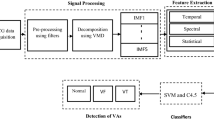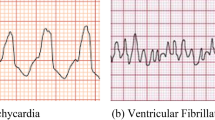Abstract
Automated methods using computer-aided decision-making process are effectively used for timely detection of VAs which are the most life-threatening conditions. In this work, we have proposed a decision support system for detection of ventricular arrhythmias (VAs) with a low computational complexity using hybrid features derived from three different transform techniques i.e. DWT, EEMD, and VMD. The methods mainly consist of a windowing technique, signal decomposition, feature extraction, and classification. About 24 time–frequency based features were extracted with 22,721 × 24 and ranked for selection of higher ranked features having maximum information of disease. The reduced feature set consists of only 6 number of highly ranked features which are then classified with SVM and decision tree classifier for efficient recognition of VAs. Aim of the reduction in data size is to reduce the computational time. Our proposed method achieves high classification accuracy in hybrid-based features and by reducing the feature dimension, it reduces the computational complexity significantly. The accuracy of 99.83% and computational time of 4.82 s is achieved when considering all 24 features. In reduced feature set, an accuracy of 99.62% with a very less computational time of 2.71 s was obtained for decision tree classifier which indicates the importance of selecting the important features for classification of VAS. With superior classification accuracy and low computation complexity, this system can be utilized in clinical practice for the recognition of ventricular arrhythmias.








Similar content being viewed by others
References
Dirk H, Bernd P, Hanspeter H, et al. Non-linear coordination of cardiovascular automatic control. IEEE Eng Med Biol. 1998;17(6):17–21.
Leisy PJ, Coeytaux RR, Wagner GS, et al. ECG-based signal analysis technologies for evaluating patients with acute coronary syndrome: a systematic review. J Electrocardiol. 2013;46:92–7.
Brugada J. Relevance of atrial fibrillation classification in clinical practice. J Cardiovasc Electrophysiol. 2002;20:S27–30.
Sun Y, Chan KL, Krishnan SM. Life-threatening ventricular arrhythmia recognition by nonlinear descriptor. Biomed Eng Online. 2005;4:6.
Mathivanan P, Ganesh AB. ECG steganography based on tunable Q-factor wavelet transform and singular value decomposition. Int J Imaging Syst Technol. 2020;31(1):270–87.
Arafat MA, Chowdhury AW, Hasan MK. A simple time domain algorithm for the detection of ventricular fibrillation in electrocardiogram. SIViP. 2011;5:1–10.
Wasan PS, Uttamchandani M, Moochhala S, et al. Application of statistics and machine learning for risk stratification of heritable cardiac arrhythmias. Expert Syst Appl. 2013;40(7):2476–86.
Miquel Alfaras M, Soriano MC, Ortín S. A fast machine learning model for ECG-based heartbeat classification and arrhythmia detection. Front Phys. 2019;7:1–11.
Sahoo S, Das T, Sabut S. Adaptive thresholding based EMD for delineation of QRS complex in ECG signal analysis. In: Int. Conf. Wireless Comm. Sig. Proc. and Network. 2016.
Maji U, Mitra M, Pal S. Characterization of cardiac arrhythmias by variational mode decomposition technique. Biocybern Biomed Eng. 2017;37:578–89.
Rai HM, Trivedi A, Shukla S. ECG signal processing for abnormalities detection using multi-resolution wavelet transform and artificial neural network classifier. Measurement. 2013;46(9):3238–46.
Rakshit M, Das S. An efficient wavelet-based automated R-peaks detection method using Hilbert transform. Biocybern Biomed Eng. 2017;37:566–77.
Nazarahari M, Namin SG, Hossein A, et al. A multi-wavelet optimization approach using similarity measures for electrocardiogram signal classification. Biomed Signal Process Control. 2015;20:142–51.
Zhang K, Aleexenko V, Jeevaratnam K. Computational approaches for detection of cardiac rhythm abnormalities: are we there yet? J Electrocardiol. 2020;59:28–34.
Martis RJ, Acharya UR, et al. Computer aided diagnosis of atrial arrhythmia using dimensionality reduction methods on transform domain representation. Biomed Signal Process Control. 2014;13:295–305.
Garcia M, Rodenas J, Alcaraz R, Rieta JJ. Application of the relative wavelet energy to heart rate independent detection of atrial fibrillation. Comput Methods Programs Biomed. 2016;131:157–68.
Asgari S, Mehrnia A, Moussavi M. Automatic detection of atrial fibrillation using stationary wavelet transform and support vector machine. Comput Biol Med. 2015;60:132–42.
Arafat MA, Sieed J, Hasan MK. Detection of ventricular fibrillation using empirical mode decomposition and Bayes decision theory. Comput Biol Med. 2009;39:1051–7.
Kaur L, Singh V. Ventricular fibrillation detection using empirical mode decomposition and approximate entropy. Int J Emerg Technol Adv Eng. 2013;3:260–8.
Xu Y, Wang D, Zhang W, et al. Detection of ventricular tachycardia and fibrillation using adaptive variational mode decomposition and boosted-CART classifier. Biomed Signal Process Control. 2018;39:219–29.
Abdalla FO, Wu L, Ullah H, et al. ECG arrhythmia classification using artificial intelligence and nonlinear and nonstationary decomposition. Signal Image Video Process. 2019;13:1283–91.
Acharya UR, Fujita H, Sudarshan VK, et al. An integrated index for detection of sudden cardiac death using discrete wavelet transform and nonlinear features. Knowl-Based Syst. 2015;83:149–58.
Zhaohua W, Huang NE. Ensemble empirical mode decomposition: a noise-assisted data analysis method. Adv Adapt Data Anal. 2009;1:1–41.
Tripathy RK, Sharma LN, Dandapat S. Detection of shockable ventricular arrhythmia using variational mode decomposition. J Med Syst. 2016;40:40–79.
Rajesh PS, Dhuli R. Classification of ECG heartbeats using nonlinear decomposition methods and support vector machine. Comput Biol Med. 2017;87:271–84.
Nguyen MT, Shahzad A, Nguyen BV, Kim K. Diagnosis of shockable rhythms for automated external defibrillators using a reliable support vector machine classifier. Biomed Signal Process Control. 2018;44:258–69.
Maji U, Mitra M, Pal S. Automatic detection of atrial fibrillation using empirical mode decomposition and statistical approach. Procedia Technol. 2013;10:45–52.
Acharya UR, Oh SL, Hagiwara Y, et al. A deep convolutional neural network model to classify heartbeats. Comput Biol Med. 2017;89:389–96.
Balasundaram K, Masse S, Nair K, Umapathy K. A classification scheme for ventricular arrhythmias using wavelets analysis. Med Biol Eng Comput. 2013;51:153–64.
Anas E, Lee S, Hasan M. Sequential algorithm for life-threatening cardiac pathologies detection based on mean signal strength and emd functions. Biomed Eng Online. 2010;9(1):43–64.
Novakovic J. Using information gain attribute evaluation to classify sonar targets. In: Telecom. forum TELFOR. 2009. p. 1351–4.
Mantas CJ, Abellán J. Credal-C4.5: Decision tree based on imprecise probabilities to classify noisy data. Expert Syst Appl. 2014;41:4625–37.
Ciaccio EJ, Biviano AB, Iyer V, Garan H. Trends in quantitative methods used for atrial fibrillation and ventricular tachycardia analyses. Inform Med Unlocked. 2017;6:12–27.
Tripathy RK, Zamora-Mendez A, Serna JA, et al. Detection of life threatening ventricular arrhythmia using digital taylor fourier transform. Front Physiol. 2018;9:1–12.
Khadra L, Al-Fahoum AS, Al-Nashash H. Detection of life-threatening cardiac arrhythmias using the wavelet transformation. Med Biol Eng Comput. 1997;35:626–32.
de Gauna SR, Lazkano A, Ruiz J, Aramendi E. Discrimination between ventricular tachycardia and ventricular fibrillation using the continuous wavelet transform. Comput Cardiol. 2004;31:21–4.
Xiao W, Gao Q, Kumar R, et al. Implementation of convolutional neural network categorizers in coronary ischemia detection. Int J Imaging Syst Technol. 2021;31:313–26.
Author information
Authors and Affiliations
Corresponding author
Ethics declarations
Conflict of interest
The authors declare that they have no conflict of interest.
Ethics statement
The paper does not contain any studies with human participants or animals performed by any of the authors.
Additional information
Publisher's Note
Springer Nature remains neutral with regard to jurisdictional claims in published maps and institutional affiliations.
Rights and permissions
Springer Nature or its licensor (e.g. a society or other partner) holds exclusive rights to this article under a publishing agreement with the author(s) or other rightsholder(s); author self-archiving of the accepted manuscript version of this article is solely governed by the terms of such publishing agreement and applicable law.
About this article
Cite this article
Mohanty, M., Dash, P. & Sabut, S. Decision Support System for Predicting Ventricular Arrhythmias Using Non-linear Features of ECG Signals. SN COMPUT. SCI. 5, 357 (2024). https://doi.org/10.1007/s42979-024-02718-3
Received:
Accepted:
Published:
DOI: https://doi.org/10.1007/s42979-024-02718-3




